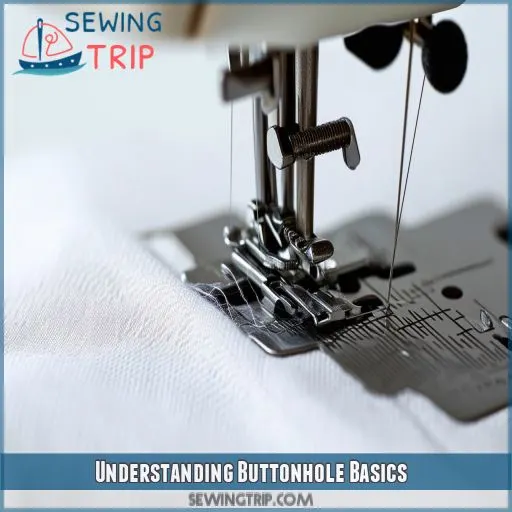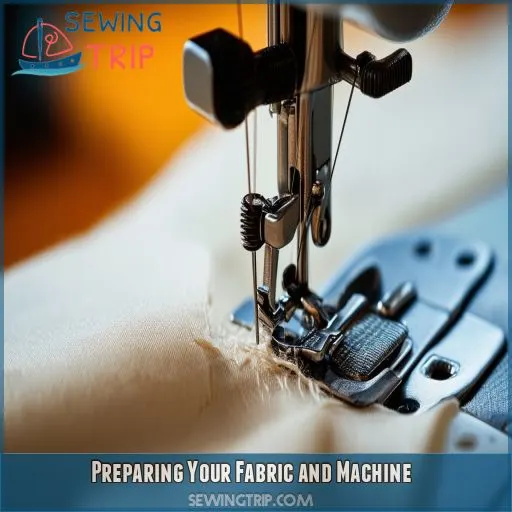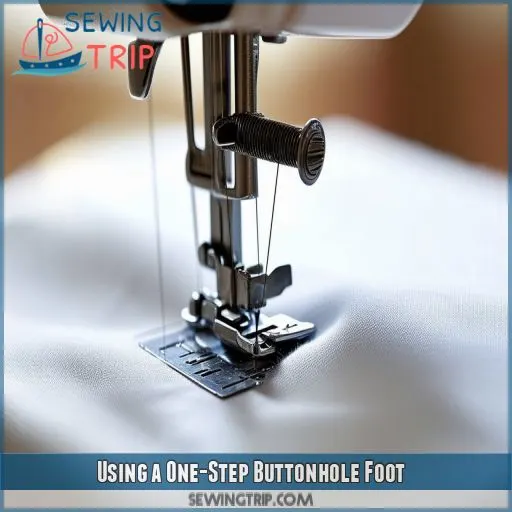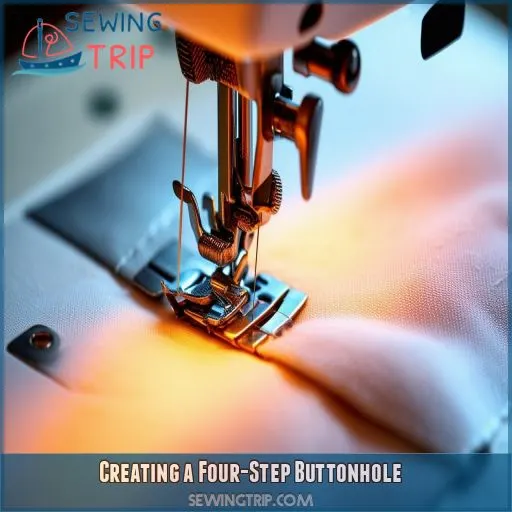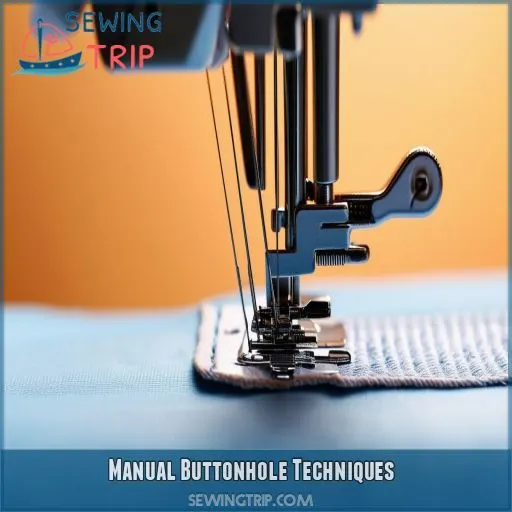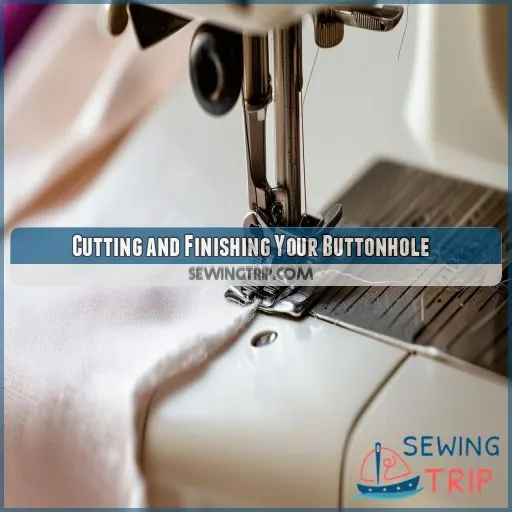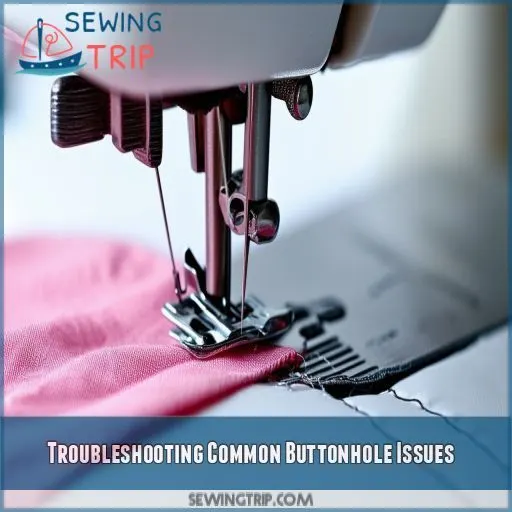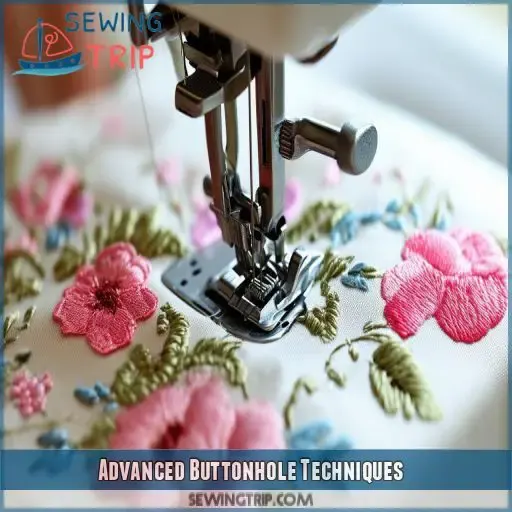This site is supported by our readers. We may earn a commission, at no cost to you, if you purchase through links.

With precise steps, you can help yourself achieve professional results every time. The tutorial takes you through the basics of buttonholes, preparation of the fabric and the machine, various methods for creating a buttonhole, cutting the hole, and troubleshooting.
Whether you are a beginner or looking to improve, you will get easy-to-follow instructions that will help you create perfect buttonholes to add that ultimate polish to your projects.
Let’s begin!
Table Of Contents
- Key Takeaways
- How to Do Buttonholes on a Sewing Machine?
- Understanding Buttonhole Basics
- Preparing Your Fabric and Machine
- Using a One-Step Buttonhole Foot
- Creating a Four-Step Buttonhole
- Manual Buttonhole Techniques
- Cutting and Finishing Your Buttonhole
- Troubleshooting Common Buttonhole Issues
- Advanced Buttonhole Techniques
- Frequently Asked Questions (FAQs)
- Conclusion
Key Takeaways
- Buttonholes on a sewing machine? Easy peasy lemon squeezy!
- Practice makes perfect, so don’t be afraid to stitch a few buttonholes on scrap fabric before tackling the real deal.
- The right buttonhole for the job depends on your fabric, button size, and garment style.
- If your buttonholes are giving you trouble, don’t despair! Refer to the troubleshooting tips to get back on track.
How to Do Buttonholes on a Sewing Machine?
Working buttonholes using a sewing machine may sound daunting, but it isn’t. Just follow these easy steps:
Choose your style to work with your fabric and the size of the button. Chalk-mark your fabric in places where the buttonholes will go. Use matching thread** and the appropriate needle.
Use a buttonhole foot on your machine and set the width and the length of your stitch. To create a one-step buttonhole, press the pedal and let the machine do its magic. With a four-step, follow through carefully according to the stitch sequence indicated.
Then cut out the hole, rounding the edges in circles so that when turned right side out, they’re nice and tight; ready to move on and master other techniques?
Understanding Buttonhole Basics
Knowing how the different buttonholes work will help you choose the right style for your project. You should consider things like the fabric you have, button size, and garment style to pick a fitting method for your buttonhole technique in sewing.
Types of Buttonholes
When working with buttonholes, you need to be aware of the various types available. The eyelet variations give a classic look, while the pearl button calls for a smaller, rounded opening. Keyhole applications are perfect for thicker buttons by providing extra space for the shank.
One benefit associated with the rounded shape is the softer appearance it creates for delicate fabrics. Rectangular buttonhole uses are common in sturdy garments.
Your buttonhole foot and stitch settings can give you the ability to get the correct size and length for a variety of buttonhole styles. Mastering these types can give you control over your projects and a sense of belonging to the sewing community.
Choosing the Right Buttonhole Style
Now that you know about buttonhole types, let’s get back to the question of the right style. The success of your buttonhole depends on three things:
- Fabric weight
- Button size
- Style of garment
On lightweight fabrics, opt for the delicate eyelet buttonholes. Whereas in heavier materials, sturdy keyhole styles work well. Decide the width and length of your buttonhole based on the shape and size of the buttons you want to use. Remember that the style you select needs to complement the overall look of your garment. Maybe your tailored blazer would do lovely with sleek rectangular buttonholes, or a whimsical blouse should be done in rounded shapes. A part of getting a professional finish for your sewing is matching the correct buttonhole style to your project.
Preparing Your Fabric and Machine
To prepare for creating buttonholes, start by marking their locations on your fabric using chalk or a fabric marker. Next, select the appropriate thread and needle for your fabric type, and set up your sewing machine with the correct stitch settings and buttonhole foot.
Marking the Buttonhole Location
Now, with some of the buttonhole basics behind you, it’s time to mark your fabric. Precise placement will give you a professional result.
Tailor’s chalk, fabric markers, or pens will all do for marking the shape of your buttonhole.
First, measure the diameter of your button and add just a smidge to that for ease; also consider the length of stitches that will go into your marking.
Selecting Thread and Needle
Choose thread that matches your fabric in color and thickness. For buttonholes, you’ll want strong thread with the right tension. Pick a needle suited to your fabric type – thicker fabrics need larger needles. Adjust your sewing machine’s stitch length to create tight, durable buttonholes. Remember, the right combo of thread, needle, and settings is key to perfect buttonholes!
Setting Up Your Sewing Machine
Now that you have your thread and needle, it’s time to set up your sewing machine for sewing buttonholes. This step is crucial for professional results. Here is what you need to do:
- Adjust stitch width and length for your chosen buttonhole type
- Install the correct presser foot (usually a buttonhole foot)
- Test settings on scrap fabric
- Ensure fabric stability with interfacing if needed
Using a One-Step Buttonhole Foot
Now that you’ve prepared your fabric and machine, it’s time to use the one-step buttonhole foot. You’ll learn how to attach the foot, adjust the buttonhole size, and stitch the perfect buttonhole with ease.
Attaching the Buttonhole Foot
Attaching your buttonhole foot is easy, but first, be sure you have the correct one for your machine. Just snap into place with the center of the foot aligned under your machine’s needle. Here’s a handy reference chart for standard buttonhole styles and their best uses:
| Style | Casual Wear | Formal Wear | Heavy Fabrics | Delicate Fabrics |
|---|---|---|---|---|
| Eyelet | ✓ | ✓ | ||
| Rounded | ✓ | ✓ | ✓ | |
| Keyhole | ✓ | ✓ | ||
| Rectangular | ✓ | ✓ | ✓ |
Adjusting Buttonhole Size
You will need to adjust your buttonhole size for a perfect fit. Using the gauge on your foot, set the width to your button width.
Consider the thickness of the fabric and stabilizer when setting your length. Depending on your fabric, you may also want to tweak the stitch tension of your machine and its needle size.
As with all projects on different fabrics, you might have to tweak them slightly.
Stitching the Buttonhole
Now that you’ve adjusted the size, it’s time to stitch your buttonhole. With your one-step buttonhole foot in place, simply press the pedal and let your machine work its magic. The foot will guide you through the process, creating a perfect buttonhole in seconds. For added flair, consider using decorative thread or creating invisible buttonholes for a polished look.
Creating a Four-Step Buttonhole
To create a four-step buttonhole, you’ll need to adjust your machine’s settings for each part of the process. Start by setting the stitch length and width according to your machine’s manual, then follow the step-by-step instructions for stitching each side of the buttonhole.
Step-by-Step Process
Creating a four-step buttonhole is a breeze when you follow these steps:
- Mark your buttonhole placement using tailor’s chalk and stabilize the fabric with interfacing.
- Set your machine to the first buttonhole stitch and sew one side, ensuring proper thread tension.
- Pivot the fabric and create the bar tack at the end, reinforcing the buttonhole.
- Sew the other side, mirroring the first, and finish with another bar tack.
Adjusting Stitch Length and Width
First and foremost, it needs a proper adjustment of stitch length and width to obtain a perfect buttonhole using a sewing machine. It depends upon the thickness of your fabric and the size or thickness of your button. Mark the buttonholes using a soluble pen or tailor’s chalk. Not to mention, also adjust the tension on the stitches for its smooth flow without tangling. Reinforce the ends of your buttonholes for added durability. Refer to the table below for guides for varied fabric thickness and stitch settings.
| Type of Fabric | Stitch Length | Stitch Width | Reinforcement |
|---|---|---|---|
| Lightness | 0.5 | 3.0 | Light bartack |
| Medium-weight | 1.0 | 3.5 | Standard bartack |
| Heavyweight | 1.5 | 4.0 | Strong bartack |
| Stretch Fabrics | 0.7 | 2.8 | Shortened zig-zag |
Manual Buttonhole Techniques
Now let’s focus on manual buttonhole techniques. You’ll learn how to create a freehand buttonhole and a zigzag stitch buttonhole, giving you flexibility for custom buttonholes.
Freehand Buttonhole Method
Creating a freehand buttonhole manually on your sewing machine is a versatile technique.
First, measure your button and mark the buttonhole length on the fabric. Sew a box of short straight stitches around the marking.
Then, switch to a narrow, short zigzag stitch to sew along one long side of the box.
For the short ends, use a double-width zigzag.
This method allows you to customize the buttonhole size and placement, perfect for unique projects. Just be sure to reinforce the fabric and adjust your stitch tension and needle size accordingly.
Zigzag Stitch Buttonhole
Next, try the zigzag stitch buttonhole method. This manual technique is great for adding a decorative touch.
First, sew a box of short straight stitches around your marked buttonhole line. Then, switch to a narrow, short zigzag stitch to sew along one long side. Use a wider zigzag to stitch across the short ends.
Cutting and Finishing Your Buttonhole
Carefully use a seam ripper to cut open your buttonholes so you don’t damage your fabric. Reinforce the edges of the buttonholes with additional stitches at the end of sewing to avoid fraying out over time and make them strong enough.
Using a Seam Ripper Safely
You will need to use a seam ripper when you cut your buttonhole safely. If your seam ripper is sharp, you can easily cut through fabric, giving you nice, clean edges. Here’s how you handle it carefully:
- Safety Precautions: Keep the fabric tight, and make slow cuts.
- Sharp Objects Handling: Always cut away from your body.
- Cutting Techniques: Start at the center and go outwards to prevent over-cutting.
Reinforcing Buttonhole Edges
This will keep these edges from fraying and thus prevent your buttonholes from coming apart. You can do this by using tighter thread tension when you make the buttonhole. It not only stops fraying but also adds strength.
The second is that the shape of the buttonhole may be rectangular or a keyhole, but constantly reinforce its edges either by hand or machine; just outline it with stitches. For extra reinforcement, you can use a buttonhole twist thread or interfacing strips on your fabric. When stitched, make a tiny zigzag all around the perimeter.
This will be the best approach for longevity—to keep that buttonhole pretty sturdy through many uses.
Troubleshooting Common Buttonhole Issues
If your buttonhole stitches are uneven or the fabric puckers, make sure you’re using stabilizer and adjust your machine’s tension settings. Getting the correct buttonhole size can be tricky, but always measure your button and use the appropriate foot.
Uneven Stitches
Uneven stitches can also wreak havoc with your buttonhole. Check your needle movement and thread tension first; they should be even. Ensure you have used the right preselected choice for a stabilizer to keep the fabric steady. Your stitch type inconsistency can also affect the shape. Always keep the stitching speed at a constant pace for the best results.
Puckered Fabric
Puckered fabric can ruin your buttonholes. Here’s how to prevent puckering:
- Use interfacing where necessary to support the fabric.
- Properly adjust the tension on your machine.
- Keep the fabric well-supported while stitching.
- Apply a lightweight stabilizer behind the buttonhole area.
Incorrect Buttonhole Size
If your buttonhole is the wrong size, it could be too tight or too loose. Double-check your measurements. If the buttonhole’s too tight or too small, the button won’t fit. If it’s too loose or large, the button will slip out. Adjust your machine settings or foot placement accordingly to correct the issue.
Advanced Buttonhole Techniques
For advanced buttonhole techniques, consider bound buttonholes, which use fabric strips to create a clean, professional finish. You can also explore decorative buttonholes to add unique designs and embellishments to your projects.
Bound Buttonholes
Bound buttonholes are a classy, professional touch that adds a sophisticated look to your garments. To start, choose firm fabric and select a medium-weight thread with an appropriate needle size for precision. Here are the key steps:
- Create Fabric Strips: Cut small strips of fabric to cover the buttonhole.
- Stitch and Cut: Sew the strips over the marked buttonhole, then cut the opening.
- Turn and Press: Turn the strips inside the cut, press, and reinforce with extra stitching.
With this technique, you’ll master an elegant finish!
Decorative Buttonholes
Are you just finished working through bound buttonholes?
Now, onto the fun stuff: decorative buttonholes. Embroidered buttonholes straddle the line between functional and decorative, wherein the stitching of elaborate patterns brings in an air of sophistication.
Bar-tacked buttonholes are reinforced at the ends for strength but stay in style.
Decorative thread buttonholes use contrasting or metallic threads to make your buttonholes pop, and fabric shapes surround appliqué buttonholes for added interest.
Covered buttonholes are covered with the same fabric as your garment to blend in, making them not visible.
These techniques will undoubtedly add a touch of flair to any garment.
Frequently Asked Questions (FAQs)
How do you make a buttonhole for beginners?
Don’t worry if it seems tricky at first. Mark the buttonhole size, use interfacing, and choose the buttonhole stitch on your sewing machine. Sew around the marking, then carefully cut the center. Practice improves perfection!
What stitch is best for buttonhole?
For creating sturdy, clean buttonholes, a zigzag stitch is best. Set your machine to a narrow, dense zigzag stitch to reinforce the buttonhole’s edges, ensuring durability and preventing fraying, even with frequent use.
Do you sew buttonholes on right side of fabric?
Yes, you sew buttonholes on the right side of the fabric so they appear clean and professional. But permanently first stabilize the fabric to prevent puckering and for lovely, sharp results.
What part of the sewing machine allows you to sew a buttonhole?
Use the buttonhole foot of your sewing machine to achieve professional buttonholes by guiding the fabric for a uniform and even stitching every time. Let your inner seamstress shine with this little handy tool!
Can buttonhole settings vary by fabric type?
Yes, buttonhole settings can vary by fabric type. Adjust stitch length, width, and tension for different fabrics. Test on scrap pieces first, and choose settings that provide strong, clean buttonhole stitches without puckering or fraying.
How to maintain buttonhole machine foot?
Clean the buttonhole foot regularly from lint and thread. You can use a soft brush to sweep this debris off. Take a little sewing machine oil and lubricate the moving parts. Then, using the manual as a guide, get the machine appropriately aligned again. Store in a clean, dry place.
What stitch length for decorative buttonholes?
For decorative buttonholes, the length of your sewing machine’s stitches should be between 5 and With this shorter exchange, the tight and smooth stitches will look bright, yet make it vital for better durability.
Is special thread needed for buttonholes?
You don’t need special thread for buttonholes; regular sewing thread works fine. However, using a strong, high-quality thread ensures durability. Cotton or polyester thread is recommended, and choose a thread color that matches your fabric.
How to fix asymmetrical buttonholes?
First, stabilize your fabric. Make precise markings and check on your adjustment on scrap fabric. Keep control over your speed, practice on scrap fabric, and then double-check that the buttonhole foot is aligned correctly before stitching.
Conclusion
Mastering how to do buttonholes on a sewing machine is something like adding a finely worked detail to your masterpiece. Provided the steps from understanding buttonhole basics to troubleshooting, you’ll have faith in making professional buttonholes.
Take time to prepare your fabric, pick the correct technique, and ensure precise cutting. You’ll find that perfect buttonholes are within your grasp, adding that ultimate polish to everything sewn, regardless of the skill level.
Practice more for even finer results.

